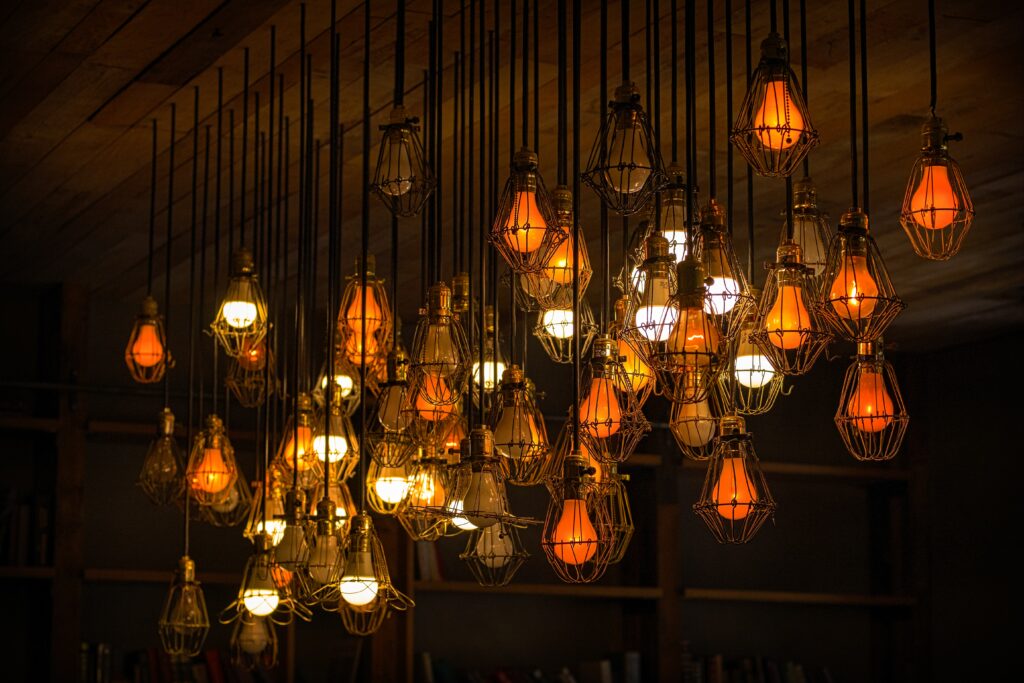Imagine walking into your home, and with a simple voice command, the lights in every room effortlessly turn on to create the perfect ambiance for any occasion. With “Smart Lighting Solutions: How To Choose The Right Lights For Every Room,” you can transform your living space into a personalized haven. This detailed guide will walk you through the process of selecting the ideal lights for each room, ensuring that you achieve both functionality and style. Say goodbye to fumbling for light switches, and say hello to a brighter, more convenient way of life.
1. Consider the Purpose of the Room
1.1 Determine the Activities
Before you start selecting lighting options for a room, it’s essential to consider the purpose of the space. Think about the activities that will take place in the room and how lighting can enhance those activities. For example, if it’s a kitchen, you’ll need bright task lighting for cooking and preparing meals. In a living room, you might want softer, ambient lighting for a cozy ambiance.
1.2 Assess the Natural Light
Take note of the natural light that enters the room throughout the day. The amount of natural light will influence your choice of lighting fixtures and bulbs. If the room receives a lot of sunlight, you might not need as many artificial lights or may opt for dimmable fixtures to adjust the brightness. On the other hand, if a room has limited natural light or small windows, you’ll need to supplement it with adequate artificial lighting.
1.3 Identify the Mood
Consider the mood or atmosphere you want to create in the room. Lighting plays a significant role in setting the mood, whether you want a vibrant and energetic space or a calm and relaxing ambiance. Understanding the desired mood will help you choose the right type of lighting and control options to achieve the atmosphere you desire.
2. Understand the Different Types of Lighting
2.1 Ambient Lighting
Ambient lighting provides general illumination to a room and is typically the base layer of lighting. This type of lighting ensures the overall brightness of the space and sets the foundation for other lighting layers. Examples of ambient lighting include ceiling-mounted fixtures, chandeliers, and track lighting.
2.2 Task Lighting
Task lighting focuses on specific activities and provides bright, directed light in a particular area. It is essential for areas where activities such as reading, cooking, or working are carried out. Task lighting fixtures include desk lamps, under-cabinet lights, and pendant lights installed over kitchen islands or tables.
2.3 Accent Lighting
Accent lighting is used to highlight specific objects or architectural features in a room. It adds depth and visual interest to the space. Accent lighting fixtures include recessed lights, track lighting with adjustable heads, and wall-mounted picture lights.
2.4 Decorative Lighting
Decorative lighting serves as an aesthetic element in a room. It enhances the overall design and style. Examples of decorative lighting include ornate chandeliers, pendant lights with unique designs, and artistic wall sconces. Decorative lighting can also serve as a focal point or statement piece in a room.
2.5 Layering Lighting
Layering lighting involves using a combination of ambient, task, accent, and decorative lighting to create a balanced and visually appealing effect. By layering different types of lighting, you can create depth, highlight specific areas, and control the overall brightness and mood of the room.

3. Choose the Right Bulb
3.1 LED Bulbs
LED bulbs are a popular choice for their energy efficiency, long lifespan, and versatility. LED bulbs produce bright, high-quality light while consuming less energy than traditional incandescent bulbs. They are available in various color temperatures, making them suitable for different rooms and purposes.
3.2 Incandescent Bulbs
Incandescent bulbs are the traditional, warm-colored bulbs that most people are familiar with. They provide a warm and cozy light but are not as energy-efficient compared to LED bulbs. Incandescent bulbs are being phased out in many countries due to their energy consumption.
3.3 CFL Bulbs
Compact fluorescent lamps (CFL) are more energy-efficient than incandescent bulbs and have a longer lifespan. They are available in different color temperatures and offer a range of brightness options. However, CFL bulbs contain small amounts of mercury and require special recycling.
3.4 Halogen Bulbs
Halogen bulbs emit a bright, white light similar to natural daylight. They are known for their excellent color rendering, making them ideal for task lighting. However, halogen bulbs are less energy-efficient than LED or CFL bulbs and can produce a significant amount of heat.
4. Determine the Light Output
4.1 Lumens
Lumens measure the amount of light emitted by a bulb. When choosing lighting fixtures and bulbs, consider the required level of brightness for the room and the specific task or activity. A higher lumen count means a brighter light output, while a lower count indicates a dimmer light.
4.2 Wattage
Wattage refers to the amount of power consumed by a bulb. In traditional incandescent bulbs, higher wattage correlates to a brighter light output. However, with the advent of more energy-efficient options like LED bulbs, the correlation between wattage and brightness is no longer as straightforward. Look for the lumen count rather than focusing solely on wattage.
4.3 Color Temperature
Color temperature refers to the appearance of light, ranging from warm yellow tones to cool blue tones. The scale is measured in Kelvin (K), with lower values representing warm light and higher values indicating cool light. For example, a color temperature of 2700K produces a warm yellow light, while a temperature of 5000K produces a cool, bluish-white light. Consider the desired ambiance and functionality of the room when selecting the color temperature.

5. Select the Lighting Fixtures
5.1 Ceiling Lights
Ceiling lights, such as chandeliers, flush mount fixtures, and recessed lights, provide general ambient lighting to the room. Consider the height of the ceiling, the size of the room, and the overall decor style when choosing ceiling lights.
5.2 Wall Sconces
Wall sconces are versatile fixtures that can be used for both ambient and accent lighting. They provide a softer, more diffuse light compared to ceiling lights and can be installed at various heights and positions on the wall.
5.3 Floor Lamps
Floor lamps are freestanding lighting fixtures that can provide ambient or task lighting. They come in various styles and designs, allowing you to find one that complements the room’s decor while providing the necessary lighting.
5.4 Table Lamps
Table lamps are convenient for adding task or accent lighting to specific areas such as desks, nightstands, or side tables. They come in a wide range of sizes, shapes, and styles to suit different room aesthetics.
5.5 Under Cabinet Lights
Under cabinet lights are practical solutions for kitchens or other areas where focused task lighting is needed. They are typically installed beneath kitchen cabinets to provide bright, directed light onto countertops for better visibility during food preparation.
6. Consider Energy Efficiency
6.1 Energy Star Certified
Look for lighting fixtures and bulbs that are Energy Star certified. Energy Star products meet strict energy efficiency guidelines and can help reduce energy consumption and utility costs.
6.2 Motion Sensors
Installing motion sensors can help save energy by automatically turning lights on and off based on occupancy. They are particularly useful in areas where lighting is often left on accidentally, such as hallways, garages, or bathrooms.
6.3 Smart Dimmers
Smart dimmers allow you to adjust the brightness of your lights, reducing energy consumption when less light is needed. They can be controlled via smartphone apps or integrated with smart home systems for more convenient and efficient lighting control.
6.4 Timers and Schedulers
Using timers or schedulers, you can program your lights to turn on and off at specific times, ensuring they are only illuminated when needed. This feature is especially beneficial when you’re away from home or want to create a sense of occupancy.

7. Pay Attention to Light Color
7.1 Warm White
Warm white light, typically around 2700K-3000K, creates a cozy and inviting atmosphere. It’s suitable for living rooms, bedrooms, and areas where relaxation and comfort are desired.
7.2 Cool White
Cool white light, around 3500K-4100K, offers a neutral and energetic tone. It’s ideal for spaces where concentration and productivity are necessary, such as home offices or work areas.
7.3 Daylight
Daylight or cool daylight, around 5000K-6500K, simulates natural sunlight. It provides a bright and refreshing light, making it suitable for areas where high visibility is required, such as garages or task-oriented areas.
8. Plan for Smart Lighting Integration
8.1 Compatibility with Smart Home Platforms
If you have a smart home system in place or plan to integrate one, ensure that your lighting fixtures and bulbs are compatible with the platforms you use. This allows you to control and automate your lights using voice commands or smartphone apps.
8.2 Wireless Connectivity and Communication Protocols
Consider the wireless connectivity and communication protocols supported by your lighting system. Common options include Wi-Fi, Zigbee, and Z-Wave. Compatibility with these protocols ensures seamless integration with other smart devices and allows for enhanced control and automation options.
9. Consider Lighting Control Options
9.1 Switches and Dimmers
Traditional switches and dimmers are simple and convenient options for controlling lights. However, consider upgrading to smart switches and dimmers for added functionality and integration with your smart lighting system.
9.2 Voice Control
Voice control through platforms like Amazon Alexa or Google Assistant allows you to control your lights with simple voice commands. This hands-free option is particularly useful when your hands are full or you want to operate your lights from a distance.
9.3 Mobile Apps and Remote Control
Smart lighting systems often come with dedicated mobile apps that allow you to control and customize your lighting from your smartphone or tablet. With remote control capabilities, you can adjust your lights even when you’re away from home.
10. Don’t Forget About Design and Aesthetics
10.1 Match the Lighting Style with Room Decor
Consider the overall design and aesthetics of the room when selecting lighting fixtures. Choose fixtures that complement the existing decor style, whether it’s modern, traditional, minimalist, or eclectic. Lighting should enhance the visual appeal of the room.
10.2 Lighting as a Focal Point
Incorporate statement lighting fixtures that can serve as focal points in the room. Chandeliers, pendant lights, or unique wall sconces can add visual interest and create a sense of luxury and elegance.
10.3 Consider Lighting Placement for Visual Interest
Pay attention to how you position and layer your lighting fixtures to create dynamic and visually appealing effects. Combine different fixture types and experiment with heights and angles to highlight specific areas or architectural features within the room.
In conclusion, choosing the right lighting for every room involves considering the room’s purpose, understanding the different types of lighting, selecting the appropriate bulbs, determining light output, choosing suitable lighting fixtures, considering energy efficiency, paying attention to light color, planning for smart lighting integration, and considering lighting control options. Don’t forget to also consider design and aesthetics, as the right lighting can greatly enhance the overall look and feel of a room. With these considerations in mind, you can create a well-lit and inviting space that meets your specific needs and preferences.


